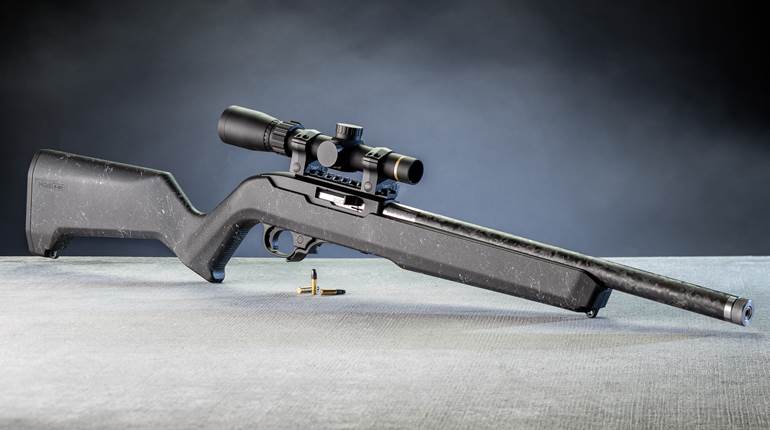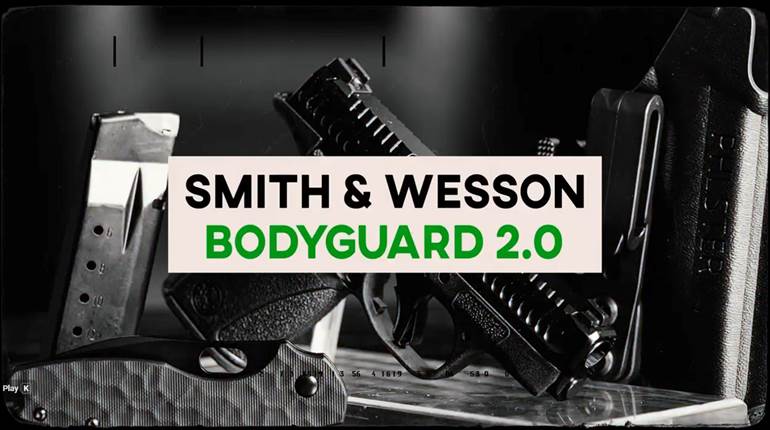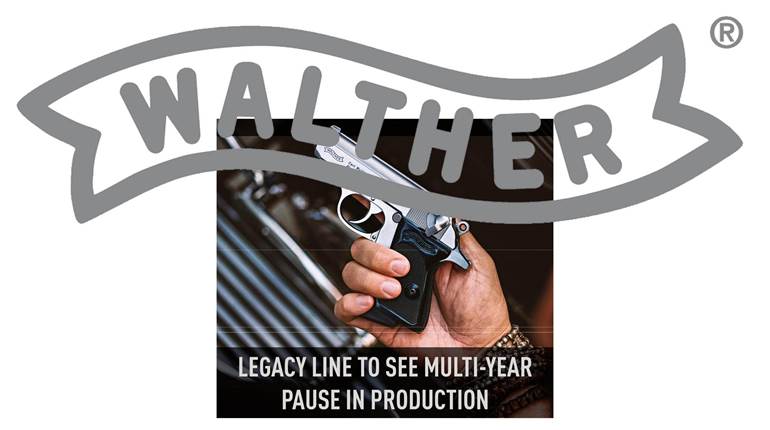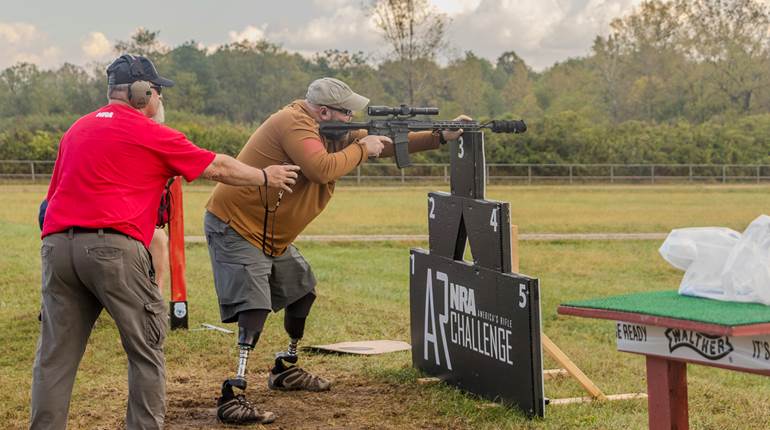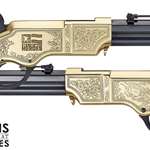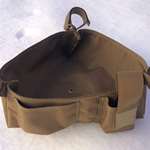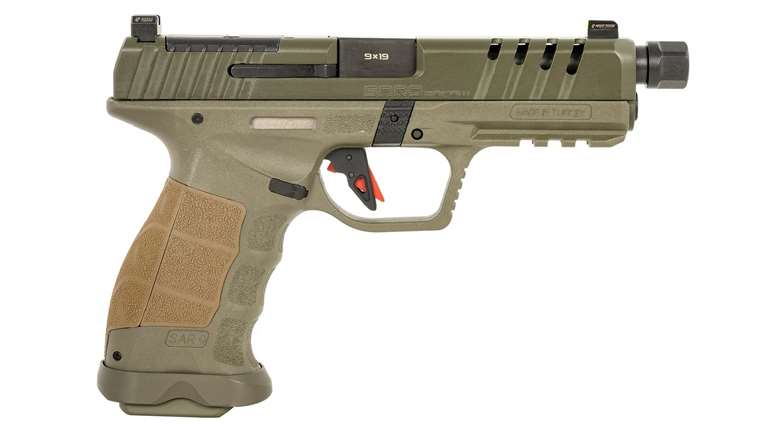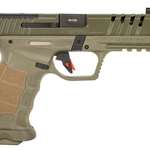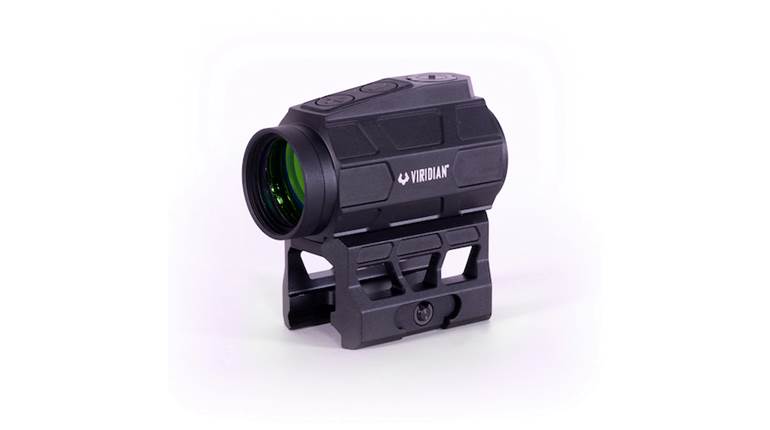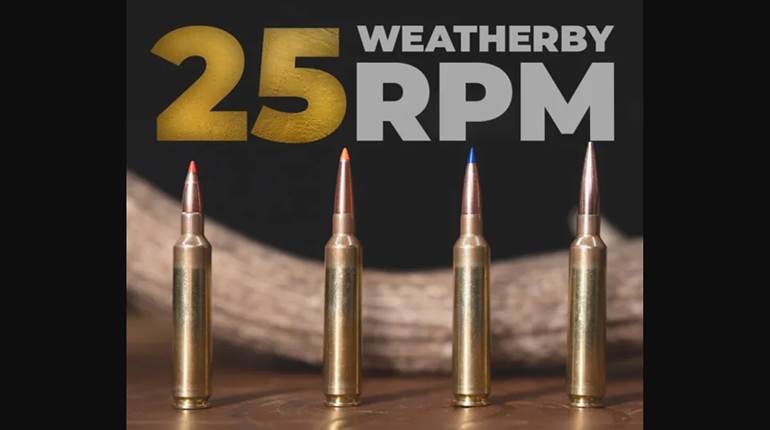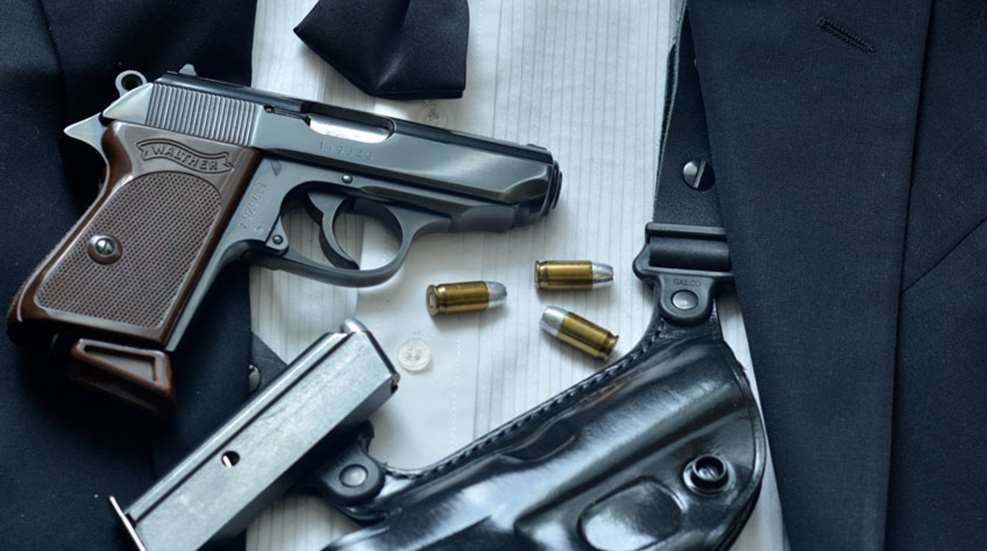
On the advice of British firearm expert Geoffrey Boothroyd, author Ian Fleming armed James Bond with a Walther PPK. The fact that 007 himself trusted his life to the dependable little Walther made it a compelling reason for gun enthusiasts all over the world to own one. Walther’s PPK is best known to a vast majority of people as the trusty sidearm of James Bond, although in the beginning the master spy was under-gunned with a diminutive .25-cal. Beretta.
Sometime in the mid-’80s, while visiting my home state of Florida, a college buddy invited me to join him for a little informal “schützenfest.” In those days, I was spending nine months a year on safari in Botswana as a professional hunter with Maun-based Safari South. While on safari, I lived with a gun in my hands, but they were long guns—medium- and large-bore rifles for big-game hunting and backing up safari clients, and shotguns for bird shooting. Most African countries prohibited handguns, so I did not own one, and my shooting experience with them was minimal. My friend was determined to rectify that flaw in my character, offering to introduce me to a whole new world of shooting by providing some trigger time with his handguns.
Slightly apprehensive at first, I held the handguns ultra-carefully, but soon warmed to their fit and feel as I handled and shot them. I observed the same safety rules that apply to rifles and shotguns and enjoyed the day’s target session enough to feel the need to add a handgun or two to my own gun collection.
A helpful gun store manager in Tampa, Fla., showed me two quality guns, either of which he recommended for a first-time handgun buyer—a 2½" Colt Python revolver in .357 Mag. and a nickel-plated Browning Hi Power 9 mm Luger semi-automatic pistol. It was tough deciding between the two, so I bought them both and got change back from $700. The combined value of those two handguns in new condition today is around $5,000.
Shortly after acquiring those first two handguns, another friend was pleased to show me his carry gun, which happened to be a Walther PPK/S. After some range time with the little .380 ACP, I felt a distinct urge to add one to my modest, but growing, collection. Learning that James Bond—007 himself—staked his life on the dependable little Walther made it all the more compelling to own one.
In early novels, Bond was woefully under-gunned. He carried a .25 ACP Beretta Model 418 semi-automatic pistol that he concealed in a chamois shoulder rig. On the advice of British firearm expert Geoffrey Boothroyd, who felt, “this sort of gun is a lady’s gun, and not a really nice lady at that,” author Ian Fleming re-armed Bond with a Walther PPK in its original 7.65 mm Browning (.32 ACP) chambering.
Fleming was grateful for Boothroyd’s advice, replying to him in a letter. “As Bond’s biographer, I am most anxious to see that he lives as long as possible and I shall be most grateful for any further technical [advice] you might like me to pass on to him,” Fleming wrote.
As a “thank you” to the firearm expert, Fleming created the character Major Boothroyd, who first appeared in Dr. No as Bond’s service armorer. To deal with the gun switch, Fleming had the silencer of Bond’s Beretta get caught in the waistband of his trousers at the end of From Russia With Love, an event that almost costs the secret agent his life. When M, the head of MI6, orders Bond to turn in his Beretta pistol, Bond argued unsuccessfully that because of the silencer, the incident would have happened with any kind of gun. Major Boothroyd replaces the Beretta with the “superior” Walther PPK and recommends Bond stay away from silencers. Further to Boothroyd’s advice, Fleming exchanged the chamois shoulder holster, which was not practical for a quick draw, with a smooth leather rig.
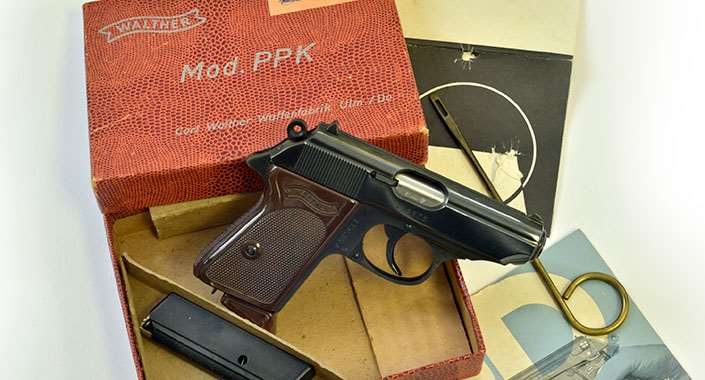
Back to the Future
But by the time Bond holstered his new PPK, the slim little semi-automatic’s reputation for unfailing dependability was already long-established by serving German military personnel, police and civilians. The story began back in 1929 when German gunmaker Carl Walther introduced the ground-breaking PP (Polizeipistole or “Police Pistol”), a sleek, double-action semi-automatic used by German military and police under the Third Reich. It was the first successful semi-automatic enabling both double-action and single-action operation. This was accomplished by way of a safety lever that served double-duty, providing not only a safe mode, but also simultaneously de-cocking the hammer with a firing pin block that allows the hammer to drop without firing the gun.
The external hammer is cocked by either thumbing it back or when the slide is pulled rearward to chamber a round. Pushing the safety lever downward releases the hammer and rotates the firing pin block into position to separate the hammer and spring-loaded firing pin. Moving the safety lever upward takes the gun out of safe mode and allows the pistol to be fired double-action by simply pulling the trigger. The slide moves rearward with the energy of the cartridge case as it is pushed to the rear by expanding gas created by the ignition of gunpowder. This blowback action ejects the empty case and re-cocks the hammer to allow the following shots to be fired in single-action mode. The slide remains open with the last shot fired. The reliable PP quickly became popular with European police and civilians alike.
The PP was originally chambered for the 7.65x17 mm (.32 ACP), providing a muzzle velocity of 948 f.p.s. A fixed barrel ensured accuracy and acted as the guide rod for the recoil spring. A loaded-chamber indicator in the form of a signal pin protruded through the rear of the slide when contacting a chambered round. By glance or feel, the user would know if the gun were loaded. The PP accommodated a single-stack magazine, holding eight rounds, and, unlike most contemporary pistols of that period with heel-catch magazine releases, it featured a frame-mounted, push-button magazine release. The overall length was 6.8", with a barrel length of 3.35" and an overall weight of 24 ozs.
Takedown is accomplished by first removing the magazine and making sure the gun is unloaded. The trigger guard is hinged at the rear and is pulled downward from the front and secured against the frame. The slide is then pulled fully rearward to disengage it from the frame and then lifted upward, allowing it to move forward and off the barrel. The recoil spring is then slipped off the fixed barrel.
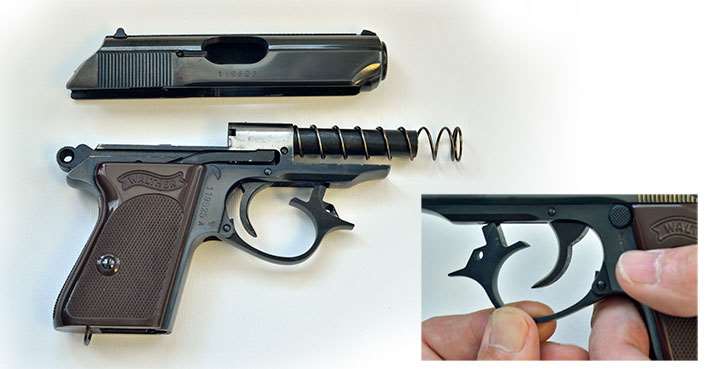
The PPK Introduction
A year later, in 1930, Walther released a smaller version of the PP, which it called the PPK (Polizeipistole Kriminalmodell or “Police Pistol Detective Model”). It featured a shorter grip, barrel, slide, frame and reduced magazine capacity. The PPK was more concealable than the original PP and more suited for plainclothes police, intelligence agents and undercover work.
During World War II, PPKs were issued to the German military, the Luftwaffe and various police agencies including the SS and Gestapo. But perhaps the most historic feat that the PPK ever accomplished was ridding the world of Nazi dictator Adolf Hitler when he used his personal service pistol, a shiny gold-plated PPK, to end his life in 1945. A PPK also ended dictatorial rule in South Korea in 1979 with the assassination of Park Chung-hee by the head of the Korean Central Intelligence Agency. This ultimately led to the beginning of democracy in South Korea.
Following World War II, the Soviet Union occupied East Germany, necessitating a move from Walther’s factory in Zella-Mehlis to Ulm. However, for several years following the war, the Allied powers prohibited all arms manufacture in Germany. Given the lack of production capacity with the prohibition of manufacturing, Walther decided to grant licenses for the production of its various products.

Walther began manufacturing again in 1952, when it licensed production of its PP/PPK series pistols to the French firm, Manfacture de Machines de Haut-Rhin, commonly known as “Manurhin.” All postwar European-made PP series pistols were manufactured by Manurhin up until 1986, with a total output numbering 1.2 million.
In addition to the German Intelligence Service (BND), the PPK was used by France’s intelligence agency (SDECE), Israel’s Mossad and Switzerland’s Intelligence and Security Service, along with the UK’s MI5 and MI6. The success of the PP and PPK as double-action semi-automatic pistols inspired the design of other pistols, including the Soviet Makarov, the Hungarian FEG PA-63, the Polish P-64, the American Accu-Tek AT-380 II and the Argentinian Bersa Thunder 380. Even the Chinese intelligence service issued a PPK clone.
In the United States, the Gun Control Act of 1968 (GCA) was enacted as a federal law aimed at regulating the firearm industry and firearm owners by restricting interstate commerce in firearms. The transfer of guns could only be done by federally licensed manufacturers, dealers and importers. There were also limits placed on imported firearms coming into the United States based on certain criteria. Under the GCA legislation, a pistol intended for import had to earn a minimum number of points for various “sporting” features, and the PPK failed to qualify. Size, weight and magazine capacity issues resulted in the GCA prohibiting the PPK from being imported—it was an ounce too light and carried too few rounds in the magazine to satisfy import restrictions.
In order to continue PPK sales in the United States, Walther overcame the restrictions by developing the PPK/S, which teamed the frame of the PP with the slide and barrel of the PPK. This added 1.8 ozs. of weight, 0.2" of height and an additional round in the magazine, which met import requirements and allowed the PPK/S to be legally imported. It is presumed that the “S” added to the PPK designation stands for “sporting,” which was the intention of the restrictions.
German-made PPK/S pistols were imported and distributed by Interarms of Alexandria, Va., but the first one manufactured in the United States was in 1978 by Ranger Mfg. in Gadsen, Ala., and it was also distributed by Interarms. In 1998, Walther’s U.S. manufacturing and distribution licenses were transferred to a Smith & Wesson assembly plant in Houlton, Maine, where the lighter PPK was made for the American market. During that time, due largely to the popularity of the Bond films, 80 percent of the PPK and PPK/S pistols made were sold in the United States.
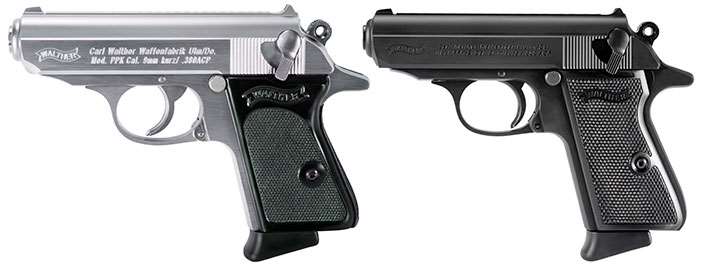
In late 2012, Walther Arms took control of its U.S. operations, locating its headquarters and assembly facility in Ft. Smith, Ark. Today, the PPK and the PPK/S are both manufactured in .380 ACP, or 9 mm Short, as the standard chambering. Assembled at the Fort Smith facility, the PPK and PPK/S designs remain faithful to the originals manufactured in Zella-Mehlis, Germany. They feature integrated front and rear sights, a decocking safety, and a smooth double-action/single-action, hammer-fired trigger system. Initially, the U.S.-made PPK and PPK/S is offered in stainless, but black finishes, as well as several special-edition projects, are planned for the future.
Walther Arms is justifiably proud of this series, describing the PPK as “nothing less than legendary.” “Once in a great while, a firearm is so popular that it becomes a cultural icon. The PPK established a defining influence on the design of concealed-carry firearms. Its elegant lines and precision engineering have a timeless appeal. And a PPK has the solid feel of pure quality” said Bret Vorhees, director of product development for Walther Arms.
“Having the PPK and PPK/S made by Walther for the first time in a long time allows us to have much better control over the quality of the pistol,” Vorhees said. “We are pleased to offer a higher quality product than what was previously available, which we feel the iconic PPK product line truly deserves.”
Produced for nearly 90 years, the PPK’s success as a military- and police-issued duty firearm is firmly established, earning it respect and praise from every corner of the world. As a PPK owner since the 1980s, I’m a big fan of the little pistol’s features that make it a reliable defensive gun. Designed with smooth lines and of a size that makes it stylish and comfortable to carry, the PPK is more than capable of serving its intended purpose. But beyond that, the PPK is just plain fun to handle and shoot.
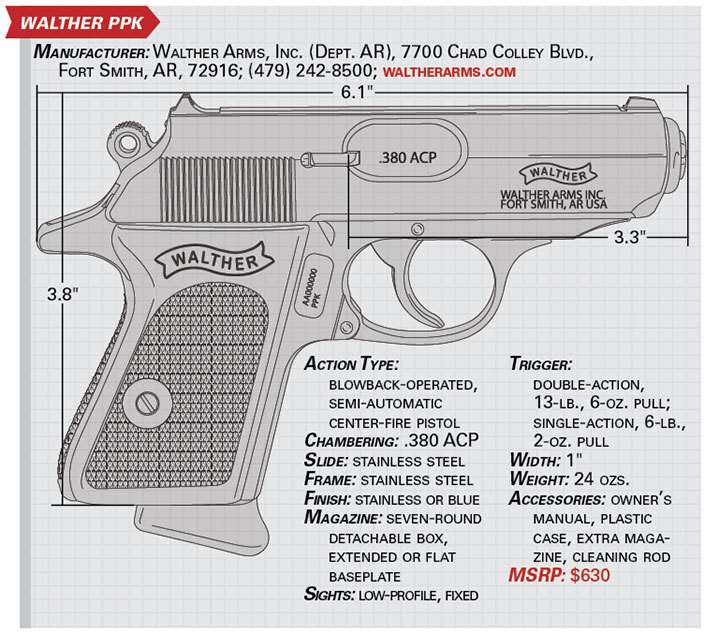
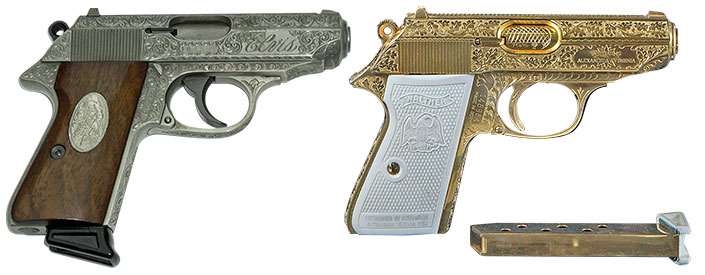
Gun Fit For A King
The PPK’s prominent placement in the James Bond franchise and other spy films has contributed greatly to its high visibility and popularity. Among its millions of fans, none other than The King himself, Elvis Presley, was a big admirer. Elvis owned at least two PPK/S pistols; one gold-plated and intricately engraved and the other featuring a nickel finish with ornate engraving on the slide, frame and portions of the grip, which included his name and Elvis’ trademark “TCB” (Taking Care of Business) and lightning bolt. The interplay of the intricate engraving on the nickel surfaces and the “TCB” medallion inlaid in the handsome wooden grip offer an impressive presentation. The gun was produced in West Germany in 1974, and as one of Elvis’ favorite pistols, it sold at auction in 2015 for a reported $62,500.












